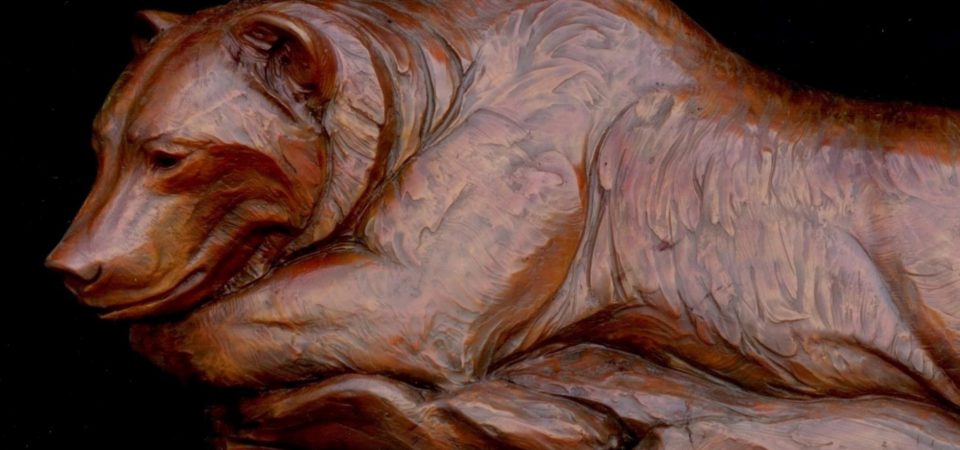
Kent Ullberg is a rare breed of environmentalist. He possesses profound environmental convictions and the ability to express them through compelling sculptures. His artwork is informed by his education in art, art history, and taxidermy; and fieldwork ranging from Botswana to dives in various oceanic locations. Kent Ullberg has dedicated himself to celebrating the beauty of wildlife, to educating the public about ecological interconnectedness, and promoting the need to protect wildlife against dangers posed by unchecked resource consumption and shrinking habitat.
Jean Kent Ullberg was born in Gothenburg, Sweden, on July 15, 1945. His father was a musician and a landscape painter who made ends meet working as a machinist, shipbuilder, and sailor. His mother was trained as a sculptor and worked as a textile artist, painter, and weaver. Ullberg’s father took him on Plein-Air painting trips as well as weekly visits to the Gothenburg Art Museum where he saw the work of Bruno Liljefors (1860–1939), a Swedish painter whose stature there is equivalent to that of John James Audubon in America. In addition to art, boyhood hobbies included fishing, the study of natural history, and taxidermy. By the time he was ten, Ullberg had memorized the Field Guide to the Birds of Europe by Roger Tory Peterson, an American of Swedish descent.
As a teenager, Ullberg studied sculpture and taxidermy at the Gothenburg Natural History Museum with its exhibits director, Björn Wennerberg. Realizing that the teen had the aptitude, interest, and talent required for a career comparable to his own, Wennerberg recommended him for admission to Konstfack, the Swedish state school of art in Stockholm, and a position in the research and exhibitions department at the National Museum of Natural History. It was during this time, in 1962, that Rachel Carson’s book Silent Spring came out and made a profound impact on Ullberg’s understanding and appreciation of ecology and the need for conservation.
After sailing to South America and back as a merchant marine, Ullberg studied painting, drawing, and sculpture at Konstfack from 1963 to 1966. While an art student, he met and dated the granddaughter of Bruno Liljefors, herself an art student, and her father, Lindorm, himself a painter. To graduate from art school, Ullberg chose as a diploma assignment, a topic that would be prophetic – sculpture in contemporary architectural design.
After graduation, Ullberg obtained a leave of absence with a stipend from the National Museum of Natural History to continue his studies in Germany, where professional training was offered in taxidermy and museum design. And from there to travel throughout Europe to study museums and museum practices. In Münster, Ullberg earned a professional certificate as a taxidermist from the German Association of Preparators and Biological Sculptors. In Berlin, he studied the sculpture and taxidermy of Karl Kästner at the Humboldt University Museum of Natural History. From Germany, Kent went to France where he studied taxidermy at the Paris Natural History Museum and works at art galleries and museums by Antoine Louis Barye and successive generations of romantic animal sculptors. He also studied works by modern masters from Brancusi to Matisse.
To fulfill a boyhood dream of seeing wildlife in Africa close up, Ullberg began writing letters to safari companies to inquire about employment. Although he never expected to leave the National Museum in Stockholm, Ullberg surprised himself in 1967 when, at twenty-two, he was offered and accepted a job as a safari taxidermist by Botswana Game Industries, with the proviso that he works for a minimum of one year. After fulfilling that obligation, he worked independently as a guide and taxidermist. Among his clients were staff from the Denver Museum of Natural History.
In 1970, Ullberg was hired as curator of the Botswana National Museum and Art Gallery. During his tenure there, he went on collecting expeditions from the Okavango River Delta to the Kalahari Desert; mounted specimens; prepared dioramas and painted their murals; organized exhibitions of local and regional artists; and managed traveling exhibitions, including one of modern sculpture by Henry Moore.
In 1972, the Denver Museum of Natural History hired Ullberg as a consultant for its African Hall and flew him to Denver. Before returning to Sweden for the Christmas holidays and then back to Africa, Ullberg spent a week in New York, where he visited galleries and museums, including the Museum of Modern Art, where he saw a bronze cast of Matisse’s relief sculpture The Back, which would later influence a Triptych he entitled, Evolution.
In 1973, the Denver museum staff returned to Botswana for a second collecting expedition. Ullberg served as host of the expedition on behalf of the National Museum and Art Gallery. A year later, Ullberg’s career and life were directed to the United States when Charles Crockett, Director of the Denver Museum of Natural History, offered him the opportunity to curate the museum’s African Hall. This opened the door for Ullberg to establish himself in the United States, which is where his career took off.
In May of 1977, at a folk festival in Denver, Ullberg met Veerle Vermeir, the Belgium-born daughter of a university professor, art critic, and author. Their common interests blossomed into a deeper relationship, and they were married in Denver on May 5, 1978. In that year, Ullberg was also elected to the National Sculpture Society. Six years later, in 1984, Ullberg attended the annual meeting of the National Sculpture Society in New York. A highlight there was the address Philip Johnson made in response to the Society’s Henry Herring Medal for Sculpture in Architecture for the AT&T Building that he had completed the same year. Johnson’s address informed and shaped Ullberg’s consciousness about postmodernism, especially when Johnson stated that representational art was displacing nonrepresentational art, just as postmodern architecture had displaced international-style architecture.
As Ullberg immersed himself in the philosophy of postmodernism, he was afforded several opportunities to develop his new-found aesthetic in noteworthy commissions. In May 1986, for example, The National Wildlife Federation commissioned Ullberg to produce a sculpture fountain for a plaza formed by the addition of two buildings to the organization’s headquarters near Washington, D.C.
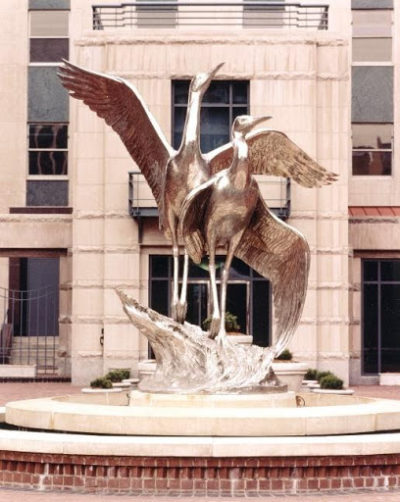
National Wildlife Federation, Washington, D.C.
This opportunity allowed Ullberg to embrace the marriage of sculpture and architecture, together with the media of cast stainless steel which he had pioneered in 1980 with Bob Zimmerman at Art Castings of Colorado, and incorporate the performing arts, by titling his composition of whooping cranes engaged in a mating dance, Rites of Spring after the ballet by Stravinsky.
On March 24, 1989, the Valdez, an oil tanker owned by the Exxon Corporation, ran aground on Bligh Reef as it departed after filling up with crude oil from the trans-Alaska pipeline terminal.
As much as 38 million gallons leaked into Prince William Sound and eventually impacted some 1,300 miles of shoreline and 11,000 square miles of ocean. As satellites broadcast images of wildlife dead and dying in the oil slick, Ullberg was moved through grief to model a somber portrait in clay of a lifeless eagle which he completed in a matter of days. When Mozart’s Requiem aired on the public radio station he was listening to in his studio, a title occurred to him that captured the pathos of the moment: Requiem for Prince William Sound. Ullberg completed Requiem within days of the disaster. Although he hoped to develop it into a site-specific monument to remind seamen of the tragedy—and found a patron to sponsor the casting—residents of Valdez didn’t want to dignify the accident through art and refused to provide a site.
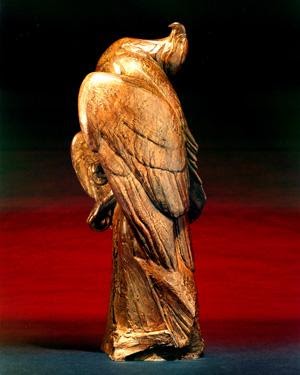
1989, Bronze, 26.5x8x8
Maquette for Exxon Valdez Oil Spill Monument
“In my work, I like to celebrate the infinite beauty I perceive in nature and hopefully communicate this feeling of preciousness to my public. But, this darker expression reflects my sadness at the violation perpetrated on the most pristine and beautiful parts of our country.“
In 1990, Ullberg took his sculpture to a new level altogether, with his epoch, Sailfish in Three Stages of Ascending an homage to Swedish Pop Artist, Claes Oldenburg, at the entrance of the Broward County Convention Center in Fort Lauderdale, with reflective pool and fountains. His initial concept evolved from a sailfish breaking through the surface of the Atlantic Ocean into a section or wedge of it.
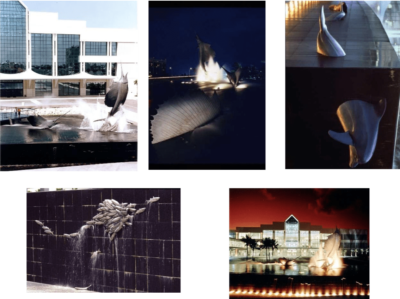
To achieve the full potential of the Fort Lauderdale Convention Center commission, project coordinator Don Murakami developed a platform to draw viewers out and over the fountain, letting them become part of the monument themselves. Jim Reeves, in turn, designed special effects: the illusion of a bow wave created by the fin of the submerged swimming sailfish, and a spray of water and night-lighting to dramatize the jump. Ullberg, Reeves, and Murakami also collaborated with the building architects to orient the monument with the postmodern architecture of the Convention Center, which incorporated a canopy in the shape of waves and an eclectic assortment of design features, ranging from classical beaux-arts symmetry to the purely decorative top of the atrium.
As the team pushed on with their design, which also included a sidewalk around the monument, Ullberg realized that its monumental scale afforded them a significant opportunity that he had not recognized. To humanize the monument and use it to educate the public, especially children, about ocean ecology, Ullberg drew on his training and work in museum exhibition design by proposing the addition of small sculpture groups of other marine life to bring layers of narrative and ecological references to the monument.
Sailfish in Three Stages of Ascending extended the relationship between sculpture, modernism, and postmodernism that Ullberg began with Rites of Spring. The work plays off the postmodern architectural design of the Broward County Convention Center and is itself a constructed environment that invites viewer participation. The large sculptures of Sailfish in Three Stages of Ascending were cast in pieces in bronze at Lands End Sculpture Center, in Paonia, Colorado, which was established by Bob Zimmerman after he sold Art Casting of Colorado in 1985. The main sailfish figure alone weighs approximately five tons. Smaller sculptures were cast at Art Casting of Colorado in Loveland. The base of the monument was faced in black granite. Sailfish in Three Stages of Ascending was unveiled in December 1991. In recognition of the achievement, the National Sculpture Society awarded Ullberg and SWA the Henry Herring Medal, the same honor it had awarded to Philip Johnson.
Since his early years, Kent Ullberg has produced more than 50 monuments and more than five times as many pedestal castings.
Sculptures by Kent Ullberg in the exhibition, ENVIRONMENTAL IMPACT II
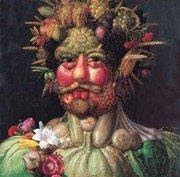
“As an art student, I became fascinated with the famous Italian Renaissance painting, Vertumnus by Arcimboldo, a portrait of Emperor Rudolf II, created from all forms of vegetables and fruits.
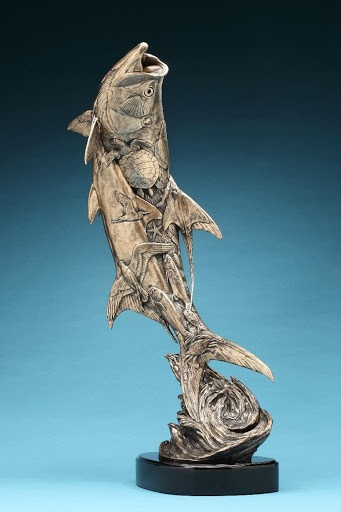
In this sculpture, Interdependency, I use the same approach, to celebrate the interdependence of marine life in an ecosystem at the Texas coast.46 different species, from microscopic plankton to mammals, come together to create the sculpture of a tarpon (a specie itself dependent on several ecosystems). This is also a symbol for interdependence in all nature, where we, too, play a part.”
A 10’ cast of Interdependency, adorns the main entrance of the University of Texas Marine Science Institute in Port Aransas. From a distance, Interdependency is a 10-foot long tarpon leaping out of the sea, but upon closer inspection, it reveals more than 50 marine plants and animals from microscopic plankton and seaweed to fishes, whales, and birds, fused to create the monument.
Interdependency and Requiem For Prince William Sound are featured in the traveling museum exhibition, ENVIRONMENTAL IMPACT II (2019-2023). They were also featured in ENVIRONMENTAL IMPACT I (2013-2016).
David J. Wagner, Ph.D., serves as Curator and Tour Director of KENT ULLBERG – A RETROSPECTIVE (2002 – 2016), ENVIRONMENTAL IMPACT I (2013-2016), and ENVIRONMENTAL IMPACT II (2019-2023).
Information about ENVIRONMENTAL IMPACT II is available at:
https://www.davidjwagnerllc.com/Environmental_Impact-Sequel.html
Information about KENT ULLBERG – A RETROSPECTIVE is available at:
http://kentullberg.net/retrospective.html
ENVIRONMENTAL IMPACT I & II and KENT ULLBERG – A RETROSPECTIVE Traveling Museum Exhibitions Produced by David J. Wagner, L.L.C.
This blog is part of MAHB’s ENVIRONMENTAL IMPACT II series, a travelling museum’s exhibition.
The MAHB Blog is a venture of the Millennium Alliance for Humanity and the Biosphere. Questions should be directed to joan@mahbonline.org
The views and opinions expressed through the MAHB Website are those of the contributing authors and do not necessarily reflect an official position of the MAHB. The MAHB aims to share a range of perspectives and welcomes the discussions that they prompt.

